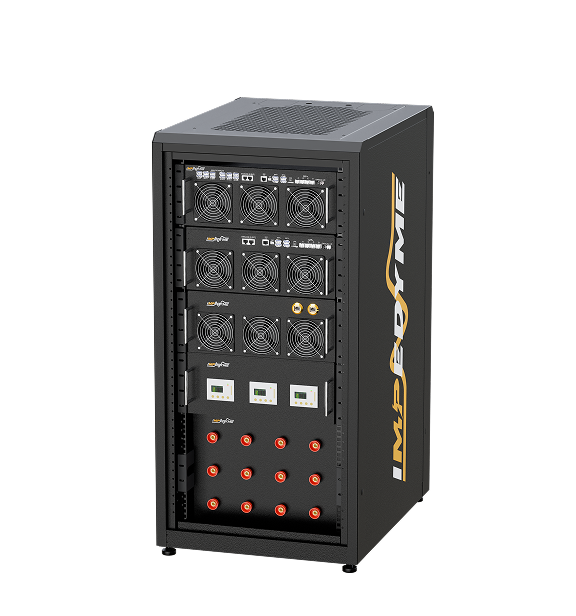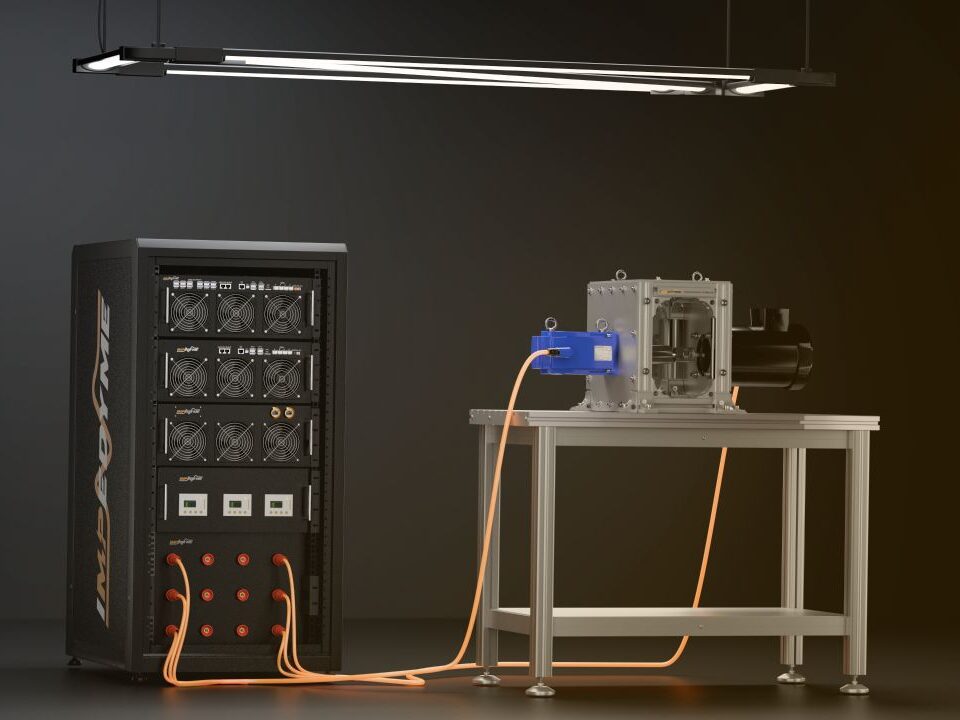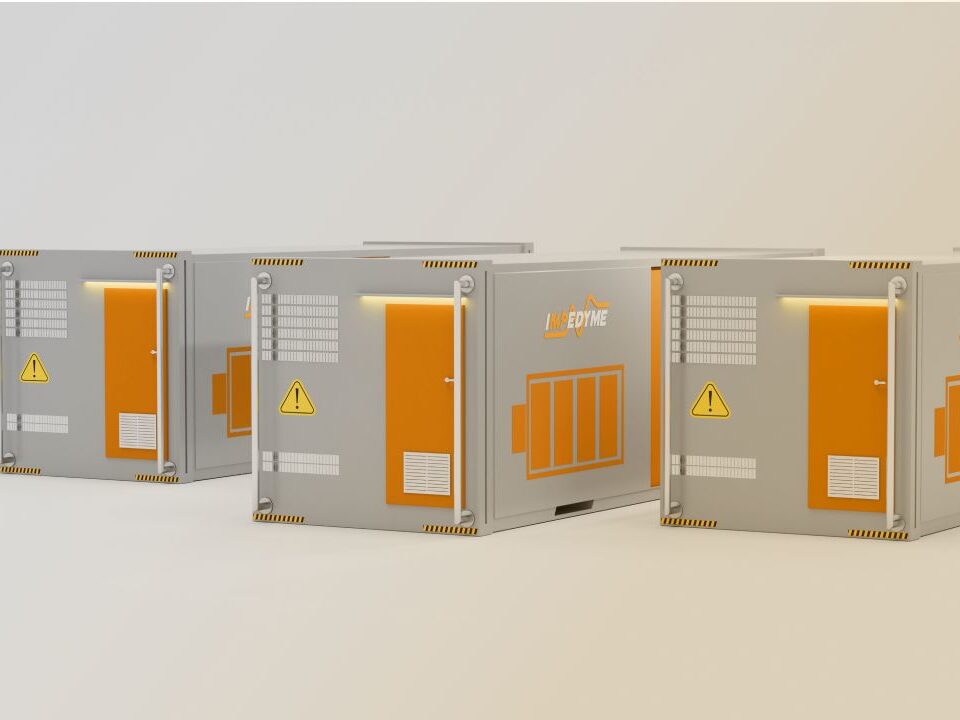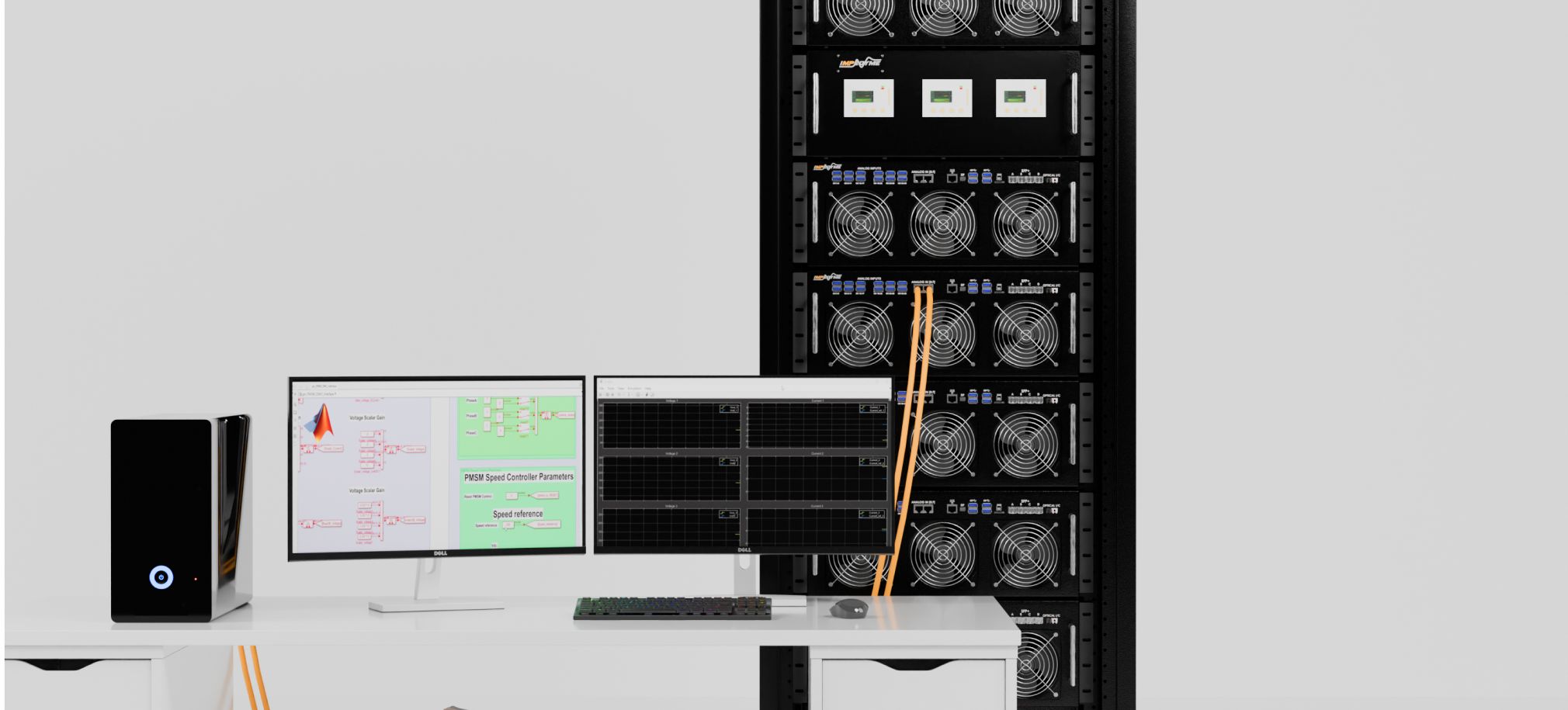
-
 Induction Motor
Induction Motor
-
 Automotive Electrical System Simulation
Automotive Electrical System Simulation
-
 DC/DC Bidirectional Converter
DC/DC Bidirectional Converter
-
 PWM Control for Brushless DC
PWM Control for Brushless DC
-
 BLDC Motor Control and Drive Simulation
BLDC Motor Control and Drive Simulation
-
 Electric Vehicle Fast Charger Simulation
Electric Vehicle Fast Charger Simulation
-
 DFIG Wind Turbine Simulation
DFIG Wind Turbine Simulation
-
 Dual Active Bridge
Dual Active Bridge
-
 EV Dynamometer Test Environment Simulation
EV Dynamometer Test Environment Simulation
-
 Electric Vehicle Simulation
Electric Vehicle Simulation
-
 Three-Phase Grid-Connected Inverter Using Direct-Q…
Three-Phase Grid-Connected Inverter Using Direct-Q…
-
 Three-Phase Grid-Connected Solar Photovoltaic
Three-Phase Grid-Connected Solar Photovoltaic
-
 Grid-Connected Rectifier
Grid-Connected Rectifier
-
 Grid-Tied Inverter System
Grid-Tied Inverter System
-
 Torque Control in a Hybrid Excitation Synchronous …
Torque Control in a Hybrid Excitation Synchronous …
-
 Wye-Delta Starting Circuit
Wye-Delta Starting Circuit
-
 IPMSM-Based Axle-Drive
IPMSM-Based Axle-Drive
-
 Simplified Parallel Hybrid Electric Vehicle
Simplified Parallel Hybrid Electric Vehicle
-
 Simplified Series Hybrid Electric Vehicle
Simplified Series Hybrid Electric Vehicle
-
 Series-Parallel Hybrid Electric Vehicle
Series-Parallel Hybrid Electric Vehicle
-
 Three-Phase Matrix Converter Simulation
Three-Phase Matrix Converter Simulation
-
 Venturini Modulation for Three-Phase Matrix Conver…
Venturini Modulation for Three-Phase Matrix Conver…
-
 Microgrid Frequency Regulation Using Vehicle-to-Gr…
Microgrid Frequency Regulation Using Vehicle-to-Gr…
-
 Three-Phase Modular Multilevel Converter
Three-Phase Modular Multilevel Converter
-
 Field-Oriented Control
Field-Oriented Control
-
 Interior Permanent Magnet Synchronous Generator
Interior Permanent Magnet Synchronous Generator
-
 Permanent Magnet Synchronous Machine
Permanent Magnet Synchronous Machine
-
 PMSM Rotor Angular Velocity
PMSM Rotor Angular Velocity
-
 PMSM-Based Electrical Traction Drive
PMSM-Based Electrical Traction Drive
-
 Maximum Power Point Tracking
Maximum Power Point Tracking
-
 Six-Phase Permanent Magnet Synchronous Machine
Six-Phase Permanent Magnet Synchronous Machine
-
 Synchronous Machine-Based Electrical Drive Simulat…
Synchronous Machine-Based Electrical Drive Simulat…
-
 Single-Stage Solar Inverter
Single-Stage Solar Inverter
-
 Three-Phase Cycloconverter Simulation
Three-Phase Cycloconverter Simulation
-
 Totem-Pole PFC Simulation
Totem-Pole PFC Simulation
-
 Twelve-Pulse Thyristor Rectifier
Twelve-Pulse Thyristor Rectifier
-
 Two-Wheeler On-Board Charger
Two-Wheeler On-Board Charger
-
 Vienna Rectifier Simulation
Vienna Rectifier Simulation
-
 High-Voltage Direct Current
High-Voltage Direct Current
-
 Wireless Power Transfer
Wireless Power Transfer
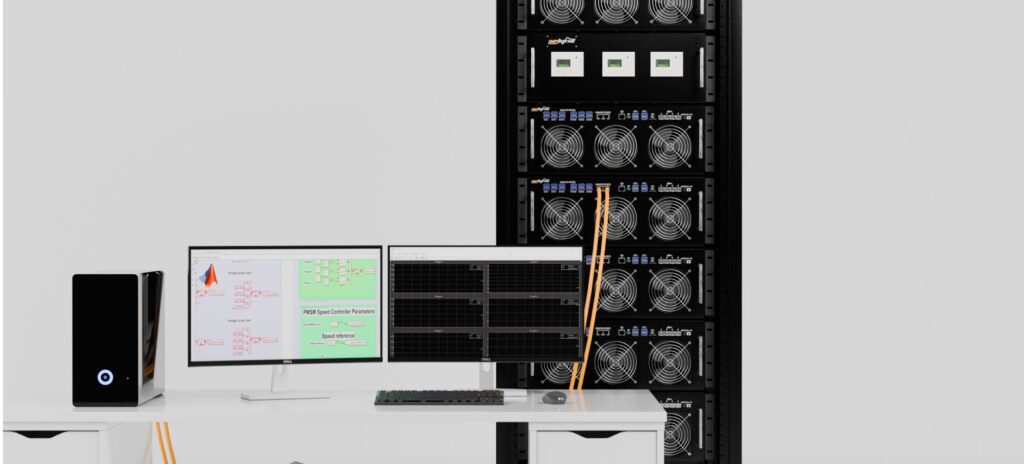
Comprehensive Documentation for Electric Vehicle (EV) Simulation and Hardware-in-the-Loop (HIL) Deployment
Table of Contents
- 1 Comprehensive Documentation for Electric Vehicle (EV) Simulation and Hardware-in-the-Loop (HIL) Deployment
- 1.1 Introduction
- 1.2 System Overview
- 1.2.1 What is EV Simulation and HIL Deployment?
- 1.2.2 Purpose of the Simulation
- 1.3 Key Features
- 1.3.1 Energy-Based Modeling for Real-Time Execution
- 1.3.2 Scalable Powertrain and Battery Models
- 1.3.3 Controller and Power Electronics Integration
- 1.3.4 Cost Savings
- 1.3.5 Faster Time-to-Market
- 1.3.6 Improved Accuracy
- 1.3.7 Enhanced Safety
- 1.4 Simulation Objectives
- 1.5 Technical Description
- 1.5.1 System Configuration
- 1.5.2 Control Methodology
- 1.6 Advantages of EV Simulation and HIL Deployment
- 1.7 Applications
- 1.7.1 Powertrain Development and Testing
- 1.7.2 Battery Performance Testing
- 1.7.3 Vehicle Dynamics and Control Systems
- 1.7.4 Thermal Management Systems
- 1.8 Simulation Benefits
- 1.9 Summary
- 1.10 Future Enhancements
- 1.10.1 Induction Motor
- 1.10.2 Automotive Electrical System Simulation
- 1.10.3 DC/DC Bidirectional Converter
- 1.10.4 PWM Control for Brushless DC
Introduction
This project focuses on modeling an electric vehicle (EV) for simulation and Hardware-in-the-Loop (HIL) deployment. The model uses energy-based techniques to improve computational efficiency while avoiding high-frequency switching effects, making it suitable for real-time applications. By integrating advanced control algorithms, this simulation provides an efficient and scalable approach for EV powertrain testing, optimization, and validation.

System Overview
What is EV Simulation and HIL Deployment?
EV simulation involves developing a digital model of an electric vehicle, including its powertrain, battery system, and control algorithms. This allows engineers to test vehicle dynamics, energy consumption, and power management strategies in a virtual environment before hardware implementation.
HIL deployment integrates the EV model with real-time hardware, enabling real-world testing of controllers, power electronics, and drivetrain components. This approach ensures accurate validation of EV systems under dynamic conditions while reducing the need for full-scale physical prototypes.
Purpose of the Simulation
The simulation aims to:
- Analyze powertrain efficiency and energy management strategies.
- Validate EV control algorithms in real-time using HIL techniques.
- Assess system interactions under different driving scenarios.
Key Features
Energy-Based Modeling for Real-Time Execution
The EV model uses an energy-based approach, eliminating high-frequency switching effects while maintaining system accuracy.
➡️ HIL/PHIL Benefit: Enables real-time execution with reduced computational load.
Scalable Powertrain and Battery Models
The simulation supports multiple powertrain configurations, including single-motor and dual-motor architectures.
➡️ HIL/PHIL Benefit: Allows seamless adaptation to various EV drivetrain topologies.
Controller and Power Electronics Integration
The system integrates motor controllers, inverters, and battery management systems (BMS) for full-system evaluation.
➡️ HIL/PHIL Benefit: Enables real-time validation of embedded control algorithms.
Cost Savings
Reduces the need for physical prototypes and testing, lowering development costs.
Faster Time-to-Market
Accelerates the testing and validation process, enabling faster product launches.
Improved Accuracy
Provides precise and repeatable test conditions, ensuring reliable results.
Enhanced Safety
Allows testing of extreme and fault conditions without risk to personnel or equipment.
Simulation Objectives
This simulation helps evaluate:
- Powertrain dynamics and energy consumption under real-world driving conditions.
- Battery charge-discharge behavior and thermal management strategies.
- Performance of control algorithms for motor, battery, and power electronics.
➡️ HIL/PHIL Benefit: Allows safe, repeatable, and scalable testing before deployment.
Technical Description
System Configuration
- Input: Drive cycle profiles (e.g., WLTP, NEDC, custom user-defined cycles).
- Output: Powertrain performance metrics (e.g., efficiency, energy consumption).
- Test Components:
- Electric Motor: IPMSM, PMSM, or IM drive models.
- Battery Model: Li-ion, solid-state, or hybrid energy storage.
- Power Electronics: Inverter, DC-DC converter, onboard charger.
Control Methodology
- Field-Oriented Control (FOC): Ensures precise motor control and efficiency.
- Energy Management System (EMS): Optimizes power distribution in real time.
- Battery State Estimation: Implements SOC, SOH, and thermal regulation strategies.
➡️ HIL/PHIL Benefit: Enables real-time testing and fine-tuning of EV control strategies.
Advantages of EV Simulation and HIL Deployment
- Rapid Prototyping: Enables early-stage validation of EV components.
- Cost-Effective Testing: Reduces reliance on physical prototypes.
- Scalable and Modular: Supports different vehicle configurations.
➡️ HIL/PHIL Benefit: Provides real-world testing without full-scale vehicle deployment.
Applications
Powertrain Development and Testing
Motor and Inverter Testing: HIL systems are used to test electric motors and inverters in real-time, validating their performance under various load and speed conditions.
Transmission and Drivetrain Testing: Simulations and HIL testing evaluate the efficiency and durability of EV transmissions and drivetrains under realistic driving scenarios.
Thermal Management: HIL systems test thermal management systems for motors, inverters, and batteries, ensu Battery Management Systems (BMS)
Battery Performance Testing
Simulations and HIL systems are used to test battery performance under different charge and discharge cycles, optimizing energy efficiency and lifespan.
State-of-Charge (SOC) Estimation: HIL testing validates BMS algorithms for accurate SOC estimation, ensuring reliable battery operation.
Fault Detection and Safety: HIL systems test BMS fault detection and safety mechanisms, improving system reliability and compliance with safety standards. ring they operate within safe temperature limits.
Vehicle Dynamics and Control Systems
Traction Control: HIL systems test and optimize traction control systems for EVs, ensuring stability and safety under various road conditions.
Torque Vectoring: Simulations and HIL testing evaluate torque vectoring systems that improve handling and performance by independently controlling the torque delivered to each wheel.
Regenerative Braking: HIL systems test regenerative braking systems, optimizing energy Autonomous and Connected Vehicles
Autonomous Driving Systems: HIL systems test and validate autonomous driving systems under various driving scenarios, ensuring safety and reliability.
Vehicle-to-Everything (V2X) Communication: HIL testing evaluates the performance of V2X communication systems, optimizing connectivity and data exchange.
Sensor Integration: HIL systems help integrate and test sensors (e.g., radar, LiDAR, cameras) used in autonomous and connected vehicles.
recovery and improving overall efficiency.
Thermal Management Systems
Battery Cooling: HIL systems test and optimize battery cooling systems, ensuring safe and efficient operation under high loads.
Motor and Inverter Cooling: HIL testing analyzes the thermal performance of motors and inverters, optimizing cooling system design.
Cabin Climate Control: HIL systems evaluate the energy consumption of HVAC systems, optimizing cabin climate control for comfort and efficiency.
➡️ HIL/PHIL Benefit: Supports accurate and repeatable testing for various EV architectures.
Simulation Benefits
With this simulation, users can:
- Optimize motor and battery control strategies for higher efficiency.
- Analyze the impact of different drive cycles on energy consumption.
- Validate powertrain performance in a risk-free virtual environment.
➡️ HIL/PHIL Benefit: Bridges the gap between simulation and real-world EV validation.
Summary
The EV Simulation and HIL Deployment framework provides a high-fidelity environment for testing and optimizing EV powertrain components. Impedyme’s HIL and PHIL solutions enhance the development process:
| Development Stage | Impedyme’s Contribution |
|---|---|
| Control Design | RCP using HIL for real-time validation |
| Control Hardware Testing | CIL with real-time EV models |
| Power Stage Verification | PHIL with actual voltage and power interaction |
| Final Validation | Full-system PHIL under realistic driving conditions |
Future Enhancements
- Integration of AI-based predictive control for EV energy management.
- Advanced thermal modeling for battery and power electronics.
- Simulation of next-generation powertrains (e.g., SiC/GaN-based inverters).
The EV Simulation and HIL Deployment project provides a comprehensive environment for developing and validating electric vehicle powertrains. With Impedyme’s HIL/PHIL solutions, engineers can optimize efficiency, reliability, and control strategies, accelerating the transition to next-generation EV technologies.
